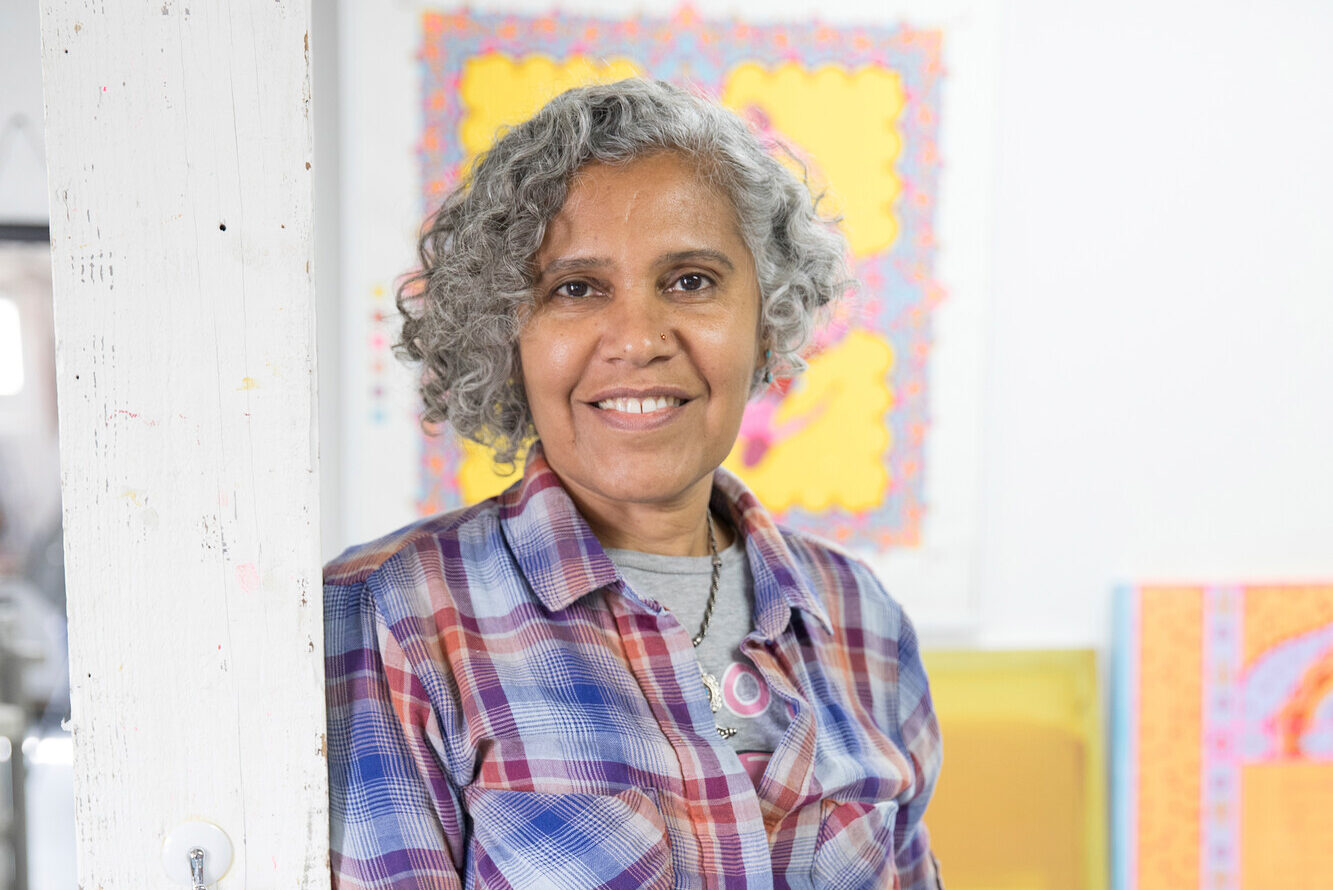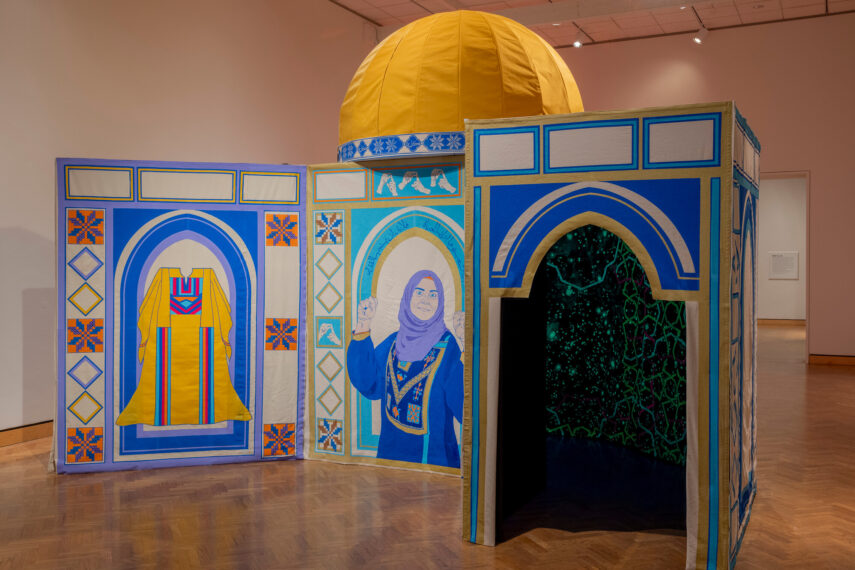
Minnesota Artist Hend Al-Mansour on the Healing Art of Representation
On September 7, 2025, join an engaging conversation between Hend Al-Mansour and Nicole Soukup, supervisor of the Minnesota Artists Exhibition Program (MAEP). The pair will discuss Al-Mansour’s current exhibition, “Hend Al-Mansour: Mihrabs: Portraits of Arab American Women,” on view through October 26, 2025, as well as her artistic practice. Yara Omer will read a poem inspired by the exhibition. The event is free, but registration is required.
By Tara Kaushik
August 20, 2025—Hend Al-Mansour is a translator of sorts, working between the realms of feeling and seeing. She conveys experiences, ideas, and emotions through her immersive, room-like installation portraits of Arab American women. Her work is animated by an appreciation for the complexity of her subjects’ lives and the breadth of their experiences, as she guides viewers through their inner worlds.
Here, Al-Mansour discusses the unexpected and interactive elements of her exhibition, “Hend Al-Mansour: Mihrabs: Portraits of Arab American Women.”
How did you decide to create these portraits?
I fled Saudi Arabia because of how I was treated as a woman seeking her independence. So that drives my goal, which is to represent women as independent, as powerful, as equal. It has been a healing exercise for me. When you grow up in that environment, it’s not easy to get rid of all the cultural baggage.
So my focus is to affirm the presence and the importance of women in society. I want to erase the position they have been put in, as “other.” Women are not “the other.” Arab people are not “the other.” We are all equal.
You conducted in-depth interviews with your subjects. What was your experience of those conversations?
I’m a timid person, but I wanted to learn about their lives, about what was important to them. I had to earn their trust. I didn’t go to places in the conversation that they didn’t want me to go. I went where I was allowed. Then I would pay attention, and I would notice, maybe a twinkle in an eye or conviction when talking about something, and then I would know, this is very important. So I would grasp that idea or that story and ask her to elaborate on it.

View of the exhibition “Hend Al-Mansour: Mihrabs: Portraits of Arab American Women” installed in the U.S. Bank Gallery at the Mia. On view through October 26, 2025.
The longer I lingered in the gallery, the more I heard, the more I felt immersed in the space. Could you share a bit about the audio components of the exhibition?
As you said, the audio components make it an immersive experience. One piece of the audio is the call to prayer, and I chose to have that play every 10 minutes. If it were continuous, it would lose its effect. I know that people might go in and out before they hear it, but at least for those who stay it will be a surprise.
And the surprise is not only the call to prayer, but also that it’s a woman who’s calling to prayer. In some Muslim countries, women can recite the Quran in public, but in Saudi Arabia that doesn’t happen. So this was one of the ways I wanted to confirm that a woman’s voice can be as valuable as a man’s. That a woman’s voice can reach Allah.
What do you hope visitors to your show come away with?
I hope visitors see and understand the contributions of Arab American women to American culture and throughout the history of Islam. Almost all my work hopes to show how Muslim and Arab women are equal in all aspects of life.
These are not exact portrayals of each woman’s life, because I am just seeing them from one point of view. It’s as if we are stars in the cosmos, and I am a little star looking at the other stars. I’m just depicting one side of each woman’s character. Their stories are snippets, and I hope people make their own stories from them. I hope they take what resonates with them and create their own interpretations.
I also want visitors to engage all their senses as they interact with and respond to the art. The more time you spend in the space and the more you observe and contemplate, the more you get. With all the colors, the sound, and the fabrics, it’s a very sensory space. Little children can have fun too, going through the installations, just seeing what they want to.
Who were your collaborators in assembling this exhibition?
I am fortunate to have some very good friends here, for whom I’m so grateful.
One of many important people in the process was William Nour, a Palestinian writer. I could not have put this show together without him. He helped me with the screenprinting, despite not knowing how to screenprint initially—he just picked it up and excelled at it.
My friend Laura Stack, an artist and educator, helped me think through questions around composition and color choice. Another friend and artist, Mary Esch, helped me sew the gold dome of the Living Threads installation, sometimes hurting her fingers in the process! Erik and Joe at Packhorse Fine Art were my fabricators, and I’m also part of an art club that gave me valuable feedback.
And my husband cooked for me all the time.
About the Exhibition
In “Hend Al-Mansour: Mihrabs: Portraits of Arab American Women,” Saudi American artist Hend Al-Mansour features four installation portraits of Arab women from Minnesota. Each work explores the women’s relationships with their heritage, as interpreted by the artist. By blending traditional motifs and architectural elements with portraiture, the artist creates unique portrayals of Arab American women and their involvement in our communities. Alongside her installations, Al-Mansour is also debuting a new animation.
Al-Mansour studied medicine in Cairo, Egypt, and practiced medicine in Saudi Arabia. She was a fellow in cardiology at Mayo Clinic, Rochester. In addition to her medical degree, Al-Mansour holds an MFA from Minneapolis College of Art and Design and an MA in art history from the University of St. Thomas in Saint Paul. She’s exhibited internationally and received numerous awards, including the Minnesota State Art Board’s (MSAB) Creative Support in 2024 and 2022, the MSAB Artist Initiative grant in 2019, the McKnight Fellowship in 2018, the Jerome Fellowship of Printmaking in 2013/14, and the Juror’s Award of the Contemporary Islamic Art in Riyadh, Saudi Arabia in 2012. Al-Mansour is a member of Rosalux Gallery; the Interfaith Artists group; and The Habibties, a group of multiethnic women artists that promotes cultural diversity in the United States.
The exhibition is on view through October 26, 2025, in the U.S. Bank Gallery.
This exhibition is part of the Minnesota Artists Exhibition Program, celebrating 50 years in 2025.
